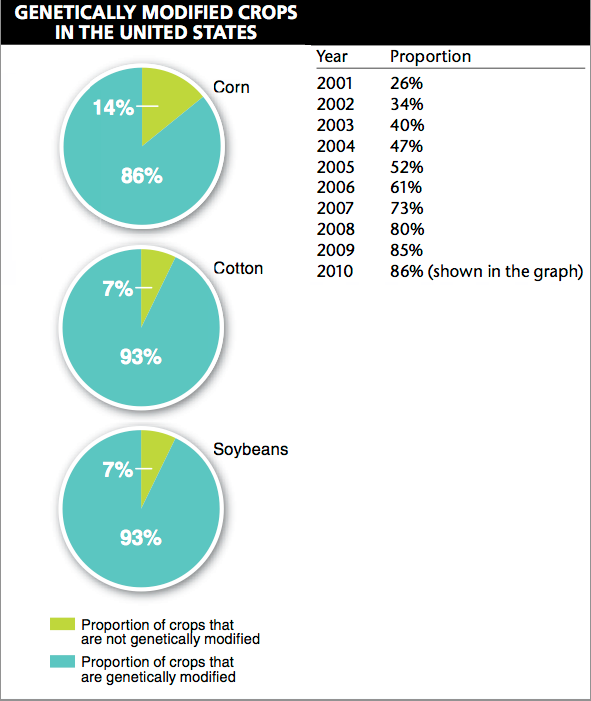Chapter 5. Chapter 5 Graphic Content
Introduction
Graphic Content
true
true
You must read each slide, and complete the question on the slide, before proceeding to the next one.

Instructions
Review the information provided in the graph to answer each question below.
After submitting your answer, you will be provided feedback to check if your response is correct.
(This activity contains 6 questions.)
Question 5.1

In the United States, 86% of the corn is genetically modified. The legend indicates that the blue portion of each pie chart represents the proportion of the crop that is genetically modified.
Question 5.2

It is not possible to determine whether more genetically modified corn or more genetically modified cotton is produced in the United States. Although it might appear that more genetically modified cotton is produced (93% vs. 86%), that only tells you the proportion of each crop that is genetically modified. The figure doesn’t give any information about the total amount produced for any of these crops. Recent data actually show that, in the United States, while corn is cultivated on 80 million acres, only about 12 million acres are used for cotton cultivation. So the absolute amount of genetically modified corn grown in the United States is much greater than the amount of genetically modified cotton.
Question 5.3

The common theme across the three pie charts is that the vast majority of these crops, whether corn, cotton, or soybeans, are genetically modified. This may be a surprise to many people and may cause them to become interested in learning more about genetically modified crops, including whether they are nutritionally different or carry any health or environmental risks.
Question 5.4

If absolute amounts were given, the figure would convey more information about the total size of the corn crop versus the cotton crop versus the soybean crop in the United States. While this might be interesting, it would deflect attention from the fact that the proportion of crops that are genetically modified is very high for all of these crops, independent of the total amount of each crop grown.
Question 5.5

The information in the question suggests that the United States is relying much more heavily on genetically modified crops than is the rest of the world. This might prompt you to investigate not just why such large proportions of crops are genetically modified but why there is such a large disparity between practices in the United States and those in the rest of the world. Is it because genetically modified crops are more commonly developed in the United States? Or are there, perhaps, fewer regulations or limitations on the cultivation of genetically modified crops in the United States? Or do consumers’ attitudes to genetically modified crops differ around the world?
Question 5.6

There are several ways to present the data in the question. You could produce a series of pie charts, one for each year. Or you could produce a bar graph, with the x-axis indicating the year and the y-axis indicating the proportion of the corn crop that is genetically modified in each year, showing one bar for each year. Or, you could produce a line graph with the same axes as the bar graph, but with a point for each year’s proportion and a line connecting them. In each of these representations, the dramatic rate of increase would be the most obvious trend.
Activity results are being submitted...